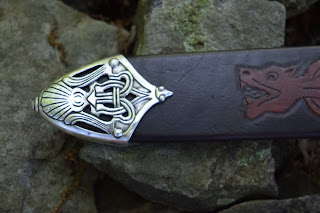This is my latest work:
The size and shape of the fittings are as close to the original as I can get based off of photos and measurements from the museum. Mine differs in that I used cast bronze fittings inlaid with silver, whereas the original is silver either inlaid or overlaid on iron using a slightly different technique. As a result my lines aren't quite as thin as the original, and I used less dots.
The handle is pure speculation. It's carved caribou antler with a design derived from the one on the fittings. There are examples of original handles made from antler, so the material and general shape are close to originals.
The pommel decorations appear to be two bears heads, which is why I call it the Trondheim Berserker. "Berserker" means "bear skin", and I suspect the bears heads were meant to help bring the spirit of the bear to the warrior wielding the original
The fittings are inlaid on all sides.
The hilt is actually hollow on this sword. The walls are about 1/8"+ thick. This gives plenty of depth for inlay and plenty of strength to protect the hand, but lightens the piece by about 100g. That may not seem like a lot, but swords are like sports cars - any little bit of weight you can save without sacrificing performance is worth it. The whole sword weighs 1264g / 2.78lbs.
The blade is 77.3cm / 30.43" long. The core is made from high carbon cable surrounded by 24 layers of 1075 and 15N20. The core is then worked into the serpent pattern.
This blade was one of two I made this winter to experiment with the serpent pattern in cable. This one has a ground in fuller so I could see what the cable pattern looked like as you cut toward the center.
The core was tapered at the tip with a fishmouth weld, and then the edge bar wraps completely around the whole sword. The edge bar is about 500 layers of 1075 and 15N20.
The scabbard is thin wooden slats lined with 100% merino wool felt. That core is then wrapped with 3oz grade A tooling leather from Wickett & Craig.
The designs embossed into the sheath are of the Gosforth Cross, which has always amused me because it's a christian cross covered with pictures of the norse gods.

The chape is based on an original found in Russia. I altered the proportions slightly to fit this scabbard. It's cast in .925 sterling silver.
The scabbard slide is done the way many originals were made. It is a wooden slide directly attached to the sheath cover and then covered over by the leather. This provides a very firm anchor for the straps.














